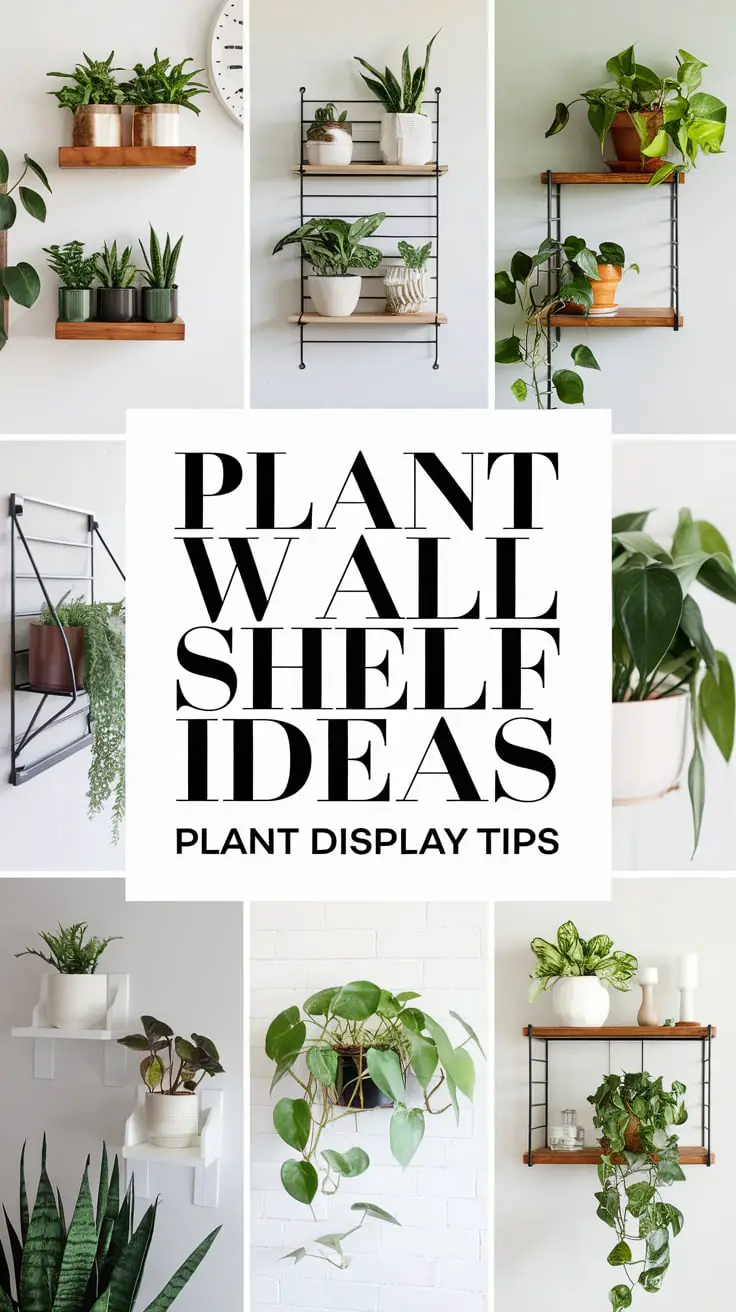Introduction
In recent times, the allure of indoor plant displays has proliferated with an intensity akin to a verdant revolution. Love for plants has transcended the traditional garden borders, creeping into our interiors with leafy charm. The innate delight these green companions bring, coupled with their ability to purify air and elevate aesthetics, is a profound motivation for incorporating them into living spaces.
As urban homes become smaller, maximizing space without sacrificing style is paramount. Enter plant wall shelves, a symbiosis of utility and beauty. These shelves are perfect for small spaces, providing a canvas for creating lush, vertical gardens which transform ordinary walls into extraordinary botanical retreats.
Choosing the Right Wall Shelf for Plants
Floating Shelves
Floating shelves are a minimalist’s dream, offering a sleek, unobtrusive platform where plants can thrive. These shelves appear to hover on the wall, adding a touch of modern sophistication. Their versatility makes them suitable for a variety of decor styles, from industrial to boho chic. The seamless integration of such shelves means they can be arranged in myriad configurations, resulting in a clean, contemporary look that allows the plants to take center stage.
Corner Shelves
Consider the unassuming corners of your home, often ignored yet brimming with potential. Corner shelves transform these spaces into verdant alcoves, utilizing what would otherwise remain redundant. Corner shelving boasts a unique structural quality, inviting viewers to step closer to admire the plants arranged in its embrace. Whether standalone designs or those built into the wall, corner shelves offer cohesion and harmony, often highlighting specific plants in a cozy, inviting manner.
Ladder-style Shelves
Ladder-style shelves invoke imagery of winding stems and reaching vines. The tiered, open design allows for light to cascade down each level, nourishing plants as they ascend the ladder. This style is perfect for displaying a gradation of plants, from trailing vines to compact succulents, each finding its niche on the rungs. The architecture of a ladder shelf is inherently dynamic, creating a sense of movement even in its stillness.
Modular Shelving Units
Flexibility and creativity find their home in modular shelving units, whose pieces can be arranged and rearranged according to the whims of the owner. Such structures adapt easily to changes, accommodating the growth and transplantation of plants. Their customizable nature allows for an ever-evolving display, responding to seasonal shifts and the lifecycle of its leafy residents. This adaptability makes modular shelving a wise investment for plant enthusiasts.
Deciding on the Placement of Your Plant Wall Shelf
Choosing Spots with Adequate Sunlight
Adequate sunlight is a non-negotiable requirement for most indoor plants. When deciding on the placement of plant wall shelves, consider areas abundant with natural light. South-facing windows often provide the most generous exposure, yet each plant’s light requirements should be individually assessed. A sunlit position enhances growth and brightens the room.
Arranging Shelves Near Windows or in Shaded Areas with Grow Lights
Not every space enjoys the luxury of abundant natural light, prompting innovative solutions like grow lights. Shelves can be strategically positioned near windows to maximize available light or supplemented with LED grow lights in darker rooms. These artificial illumination sources mimic sunlight, supporting photosynthesis and maintaining the health of your indoor garden. Selecting stylish and energy-efficient lights ensures they contribute aesthetically while fulfilling their function.
Selecting the Best Plants for Wall Shelves
Ideal Plants for Shelves: Trailing, Small, and Low-maintenance Plants
The constraints of shelf spaces necessitate selection of plant species that thrive in restrained conditions. Trailing plants like pothos, with its cascading tendrils, are striking when draped over the edges of a shelf. Small plants, such as succulents or cacti, are perfect companions, requiring little space and effort. Low-maintenance varieties further enhance the shelving experience, ensuring plants remain lush and vibrant with minimal intervention.
Like Us on Facebook!
Popular Choices: Pothos, Succulents, Ferns, and Air Plants
Certain plants have emerged as staple choices for wall shelves. Pothos, known for its resilience, provides lush, green coverage. Succulents, with their intriguing shapes and minimal water needs, are perfect for beginners. Ferns introduce texture and depth with their feathery fronds. Air plants defy traditional planting, capable of thriving without soil – an asset when seeking unique, low-maintenance greenery.
Subscribe Us on YouTube!
Arranging Plants for Visual Appeal
Creating Height Variations with Different Sized Pots
Visual harmony on a plant wall shelf stems from the orchestration of height variations. Employing different sized pots creates an engaging skyline of greenery. Taller plants can occupy higher positions, while diminutive species adorn lower tiers. This varied topography not only showcases each plant uniquely but also orchestrates a rhythm that captivates the eye.
Mixing Hanging Plants with Upright Ones for Dynamic Displays
Punctuating static plant arrangements with both hanging and upright species introduces movement and diversity. Trailing vines juxtapose with structured, upright plants, creating a dynamic interplay. Shelves play host to a living tapestry, with hanging plants cascading over sides, gently swaying in ambient drafts. Such diversity in arrangement reflects the wild, unrestrained beauty of nature itself.
Styling Plant Shelves with Decorative Elements
Adding Vases, Books, and Small Sculptures for Balance
The aesthetic of a plant wall shelf is enhanced by curated accessories like vases, books, and trinkets. Vases, empty or filled with blooms, punctuate the green expanse, while books add intellectual gravity, doubling as pedestals for smaller pots. Sculptures, whether abstract or classical, introduce whimsy and interest, fostering a cohesive visual narrative.
How to Combine Plant Displays with Personal Decor
Integrating personal decor within plant displays personalizes the space, rendering it uniquely yours. Objects of sentiment, whether souvenirs from distant lands or family heirlooms, find camaraderie amongst the greenery. This amalgamation weaves personal stories with botanical beauty, forging a tapestry of memory and growth upon your wall.
Maximizing Small Spaces with Vertical Plant Displays
Installing Multiple Tiers of Shelving to Create a Green Wall
Vertical growth is a key strategy in small space design. By installing multiple tiers of shelving, one can cultivate a towering green wall. This method maximizes plant capacity without consuming floor space, effectively cloaking a wall in nature’s embrace. Such installations speak to both maximalist design and ecological ambition, transforming the spatial limitations into statements of abundance.
Staggering Shelf Heights to Fit More Plants Without Overcrowding
Avoid the pitfalls of overcrowding by staggering shelf heights. This approach allows ample room for each plant to bask in light while creating an airy, deliberate asymmetry. Thoughtful positioning of shelves ensures that no plant is overshadowed, their individual beauty accentuated by the negative space.
Mixing Plant Types on Your Shelves
Combining Leafy, Flowering, and Succulent Plants
The fusion of diverse plant types cultivates a rich tapestry of textures and forms. Leafy greens provide lush volume, flowering species introduce vibrant splashes of color, and succulents contribute sculptural intrigue. This eclectic mix plays against expectation, ensuring a captivating and multifaceted display, each type fulfilling a distinct role in the symphonic assemblage.
How to Balance Different Textures and Colors for a Vibrant Display
Establishing equilibrium among textures and colors is crucial for harmonious plant arrangements. Balance vibrant florals with the serene green of leaves; complement sharp, angular succulents with the soft curves of a philodendron. Encourage contrast and cohesion, ensuring each plant enhances its neighbor, speaking in unison rather than in solitary bursts.
Incorporating Plant Care into Your Shelf Design
Choosing Shelves that Are Easy to Water Without Creating Mess
Functionality lies at the heart of sustainable plant displays. Opt for shelves that allow easy access for watering without the risk of spillage. Materials such as wood or laminate with water-resistant finishes not only provide visual warmth but also practical resilience. Incorporate the use of watering cans specifically designed for indoor gardening, which feature narrow spouts for precision pouring.
Using Trays or Saucers to Catch Excess Water
Trays and saucers are indispensable allies in plant shelf maintenance, discreetly capturing excess water. This simple addition prevents water damage to shelves and walls. Choose designs that complement pot styles, ensuring functionality is camouflaged as part of the aesthetic. Such elements maintain the integrity of both your plants and your walls.
Grouping Plants Based on Light and Water Needs
Placing Plants with Similar Care Requirements Together
Strategic grouping of plants based on their care requirements simplifies maintenance and promotes thriving growth. Place plants with similar sunlight or watering needs within close proximity, allowing care routines to be consistent and efficient. This thoughtful arrangement minimizes the risk of neglecting the divergent demands of individual species.
Tips for Organizing Sun-loving vs. Low-light Plants
Segregate sun-loving variants from those that thrive in low-light environments. Elevate heliotropic species closer to natural light sources, reserving shaded corners for those with lesser light demands. Such a pragmatic allocation ensures each plant reaches its potential, basking in optimal conditions dictated by their intrinsic biological inclinations.
Choosing the Right Pot for Your Plant Shelf
Terracotta, Ceramic, and Hanging Planters
Pot choice profoundly impacts both plant health and the aesthetic of a plant display. Terracotta pots, with their earthy rustic charm, provide breathability due to their porous nature, beneficial for succulents and cacti. Ceramic pots, available in myriad designs and hues, lend character and elegance, serving as distinguished vessels for verdant treasures. For hanging arrangements, lightweight planters are essential, reducing strain on both the plants and their supports.
Using Lightweight Pots to Avoid Overloading Shelves
The structural integrity of shelves should never be compromised. Lightweight pots are an excellent precaution against potential overloading. Select materials such as plastic or lightweight fiberglass, which offer durability without the burden of weight. This consideration preserves both your living wall and the safety of its surroundings.
Decorating with Macramé Plant Hangers
How to Combine Hanging Plants with Shelf Displays
The artfulness of macramé introduces bohemian flair and dynamic variation to plant displays. When combined with shelving, hanging plants within these woven wonders creates levels of visual interest. This complements static shelves, ensuring the overall design features flowing elements that draw the eye upwards.
Creating Balance with Macramé for a Bohemian Touch
Balance is critical in crafted displays, with macramé serving as a soft counterpoint to the rigid lines of shelving. Its intricate knots provide a tactile contrast, its presence diffusing the formality of structured shelves. This juxtaposition instills a bohemian touch, capturing a spirit of freedom and individuality.





















